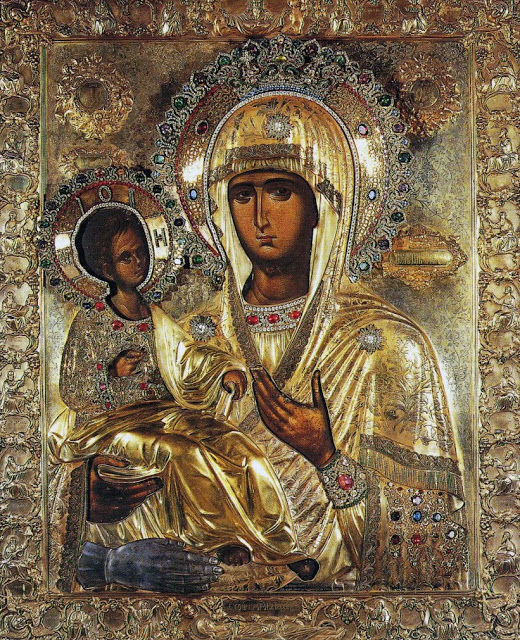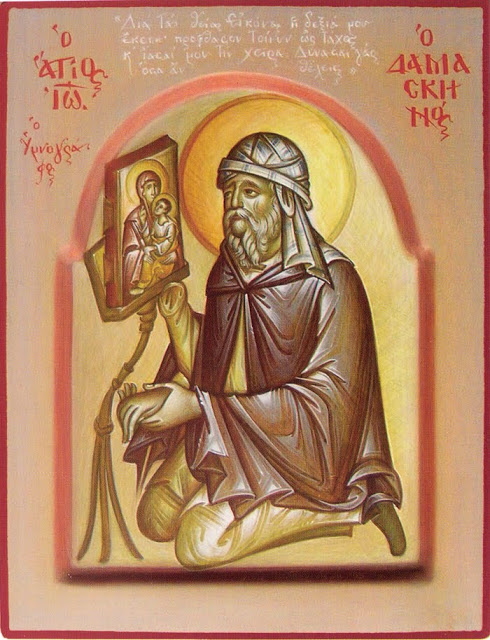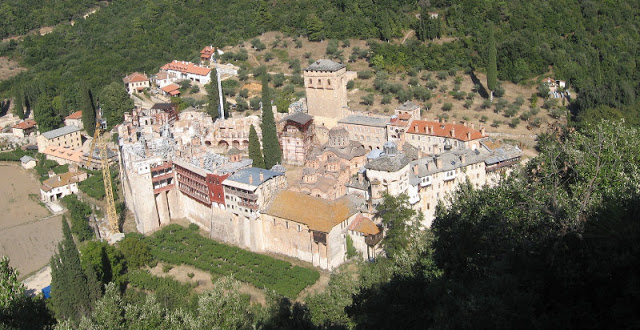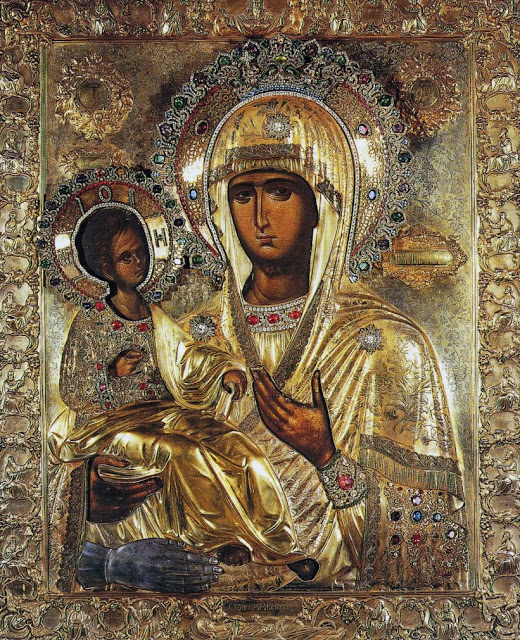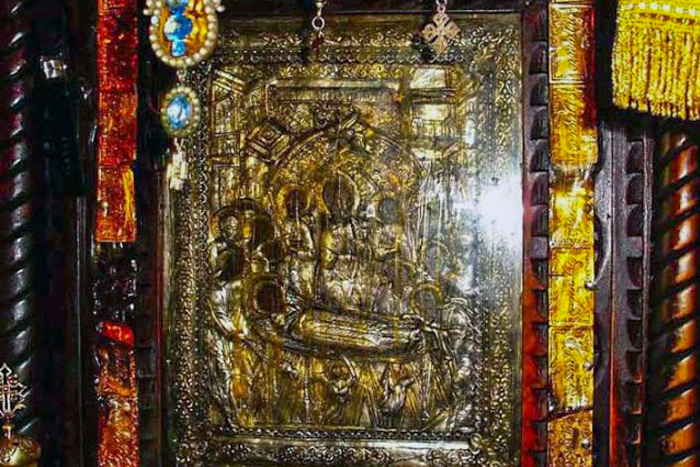The story of the cut off hand
The base of Icon of the Mother of God of “The Three Hands” is a traditional image of the Mother of God Hodegetria. Infant Christ is pictured sitting on the right hand, and the left one is raised and is pointing at the Son. There are several version, which explains the appearance of the third hand.
The most popular one is connected with the name of Saint John of Damascus. The saint came into conflict with the Byzantine emperor-heretic Leo III the Isaurian for honoring the holy icons during the iconoclasm. John was a friend of the mighty caliph from the Umayyad clan, and the emperor Isaurian decided to defame him. He ordered to imitate John’s handwriting and to write a fake letter, in which John appeals the Byzantine Empire to attack Damask. When the caliph received that letter he was furious and ordered to cut off John’s right hand in spite of all his previous achievements. The cut off hand was hanged at the market place in the city.
When John got his hand back, he began to pray in front of the icon of the Mother of God and asked Her to heal his hand, which had served for many years in the name of God and Christianity and had written many texts defending the Holy Icons. After his hand was miraculously healed, St. John placed a silver right hand on the icon in memory of the miracle. John’s vow was really simple: to serve God and the Holy Theotokos and to glorify Them. The following words of joy were attributed to him: “Your holy hand healed the cut off one of mine, and it will destroy all your enemies and all of these who trample the holy images of You and Your Mother. These who defile the icons will be crushed in Your honor”.
The abbot from Athos
The story about the healing of Saint John of Damascus was wide-spread in the area of the Holy Mount Athos, as well as the other and even more ancient stories. There is a story about an icon-painter from the Serbian monastery – Hilandar. The icon-painter was working on the icon of the Mother of God and an image of the third hand kept appearing. He attempted to erase the hand twice. Then he saw the Mother of God in his sleep, and She ordered him to leave the image as it is – “for the purpose of wonder-working, but not by human hand”. It is an interesting fact, that the icon was kept in the Hilandar Monastery since ancient times (and it is still there), but on this very icon the hand is in the form of a silver decoration. Many researchers say it dates back to the 14th century and is considered to have been brought from Serbia. There is no precise information about it, but this theory accords with tradition. At the same time the variants of the tradition differ: one version says the icons was tied to the donkey’s back, which came once to the gates of the Hilandar Monastery from Serbia, where the Muslims took power. There is also a story about the miracle: when the monks were arguing about who should become new father superior, the icon moved itself from the altar to the abbot’s place showing that the Mother of God is the prioress of the monastery, Herself!
There is a unique image of the Mother of God in the White church of the village Caran (1340-1342). Lady Mary is painted in full growth wearing a long blue tunic. She takes Christ with the right hand and pointing at Him with two left ones. The late copy of the icon of Hilandar became the main relic of the Troyan Monastery in Bulgaria. The feature of this icon is that it has not one but three silver hands covering the painted ones.
The sacred image with an inscription
People in Russia began to glorify the Icon of the Mother of God of “The Three Hands” quite late. In the second part of the 17th century, patriarch Nikon strived to turn Moscow into the center of the orthodoxy and brought many of Greek relics. Among them was also the icon of the Mother of God of Iveron, which later became one of the most revered in Russia. The patriarch asked to send several copies of the Icon of the Mother of God of “The Three Hands” from Hilandar. One was ordered for Princess Maria Ilyinichna, the second one was brought in 1661 and was placed in the New Jerusalem Monastery. It is well-known, that the unusual icon confused people. In the beginning of the 18th century a special inscription with the story of the icon was placed near the image. It told the story about the icon-painter and the picture of the third hand, but it told nothing about St. John of Damascus.
It seems that the icon and the copies were widespread mostly in Moscow. One of them was kept in the Danilov Monastery, the other one, painted in 1718 by icon-painters Artemiy Fedorov and Afanasiy Ivanov, was brought to the Beloberezhskaya Poustinia. The icon from this monastery was well known for its miracles and was popular among the pilgrims. The third hand on this icon was painted as a real one which seemed to appear from under the garments. The same iconography was noted on the other icons and drawings of the 18-19th centuries. It is possible that these icons bothered the Holy Synod of the Russian Church, and the icon was listed as “one contradicting nature, history and truth”. Different stories make the icon-painters paint the third hand in different ways. While the story about John of Damascus told about a silver decorative hand, the traditional story about the icon-painter allowed to paint all three hands in a similar manner.
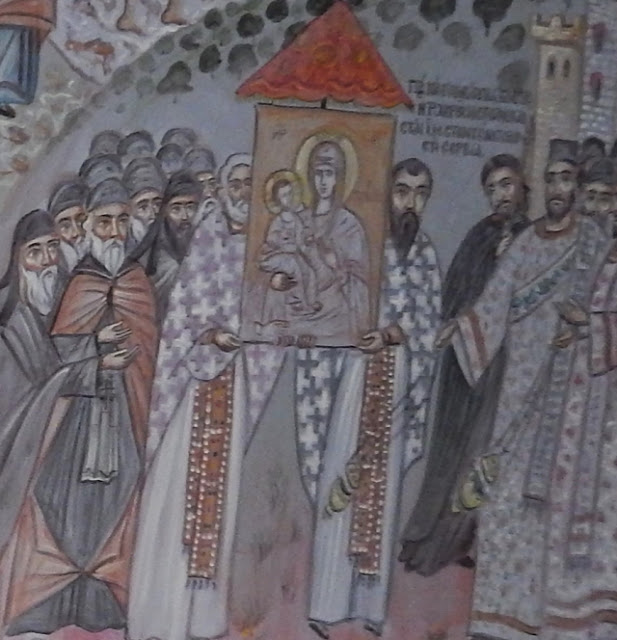
Despite all the contradictions in the legends about the icon and its further story, we can understand the sense of this unusual iconography with the help of its troparion. According to the text, the Mother of God takes the Son with two hands, but the third one symbolizes protection for all praying people. Here is the full troparion:
From Palestine, the godly-minded Sava / brought us your venerable icon, O holy Bride of God, / which is known as the icon “Of the Three Hands”; / and now, since the monks of Hilandar possess it as their boast, / they send up hymns of praise and thanksgiving, / crying out in exultation: / Rejoice, O full of grace!
Translated by the Catalogue of Good Deeds
